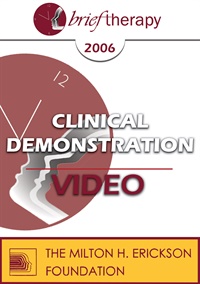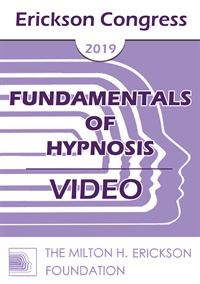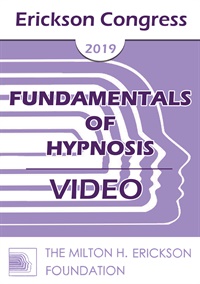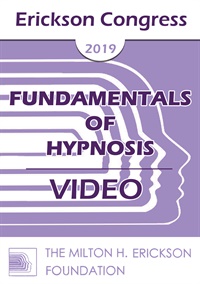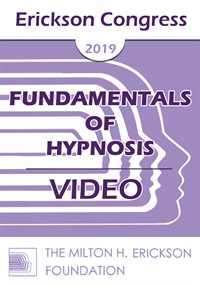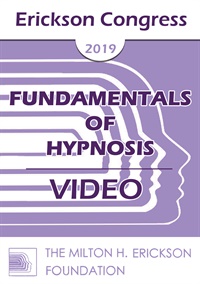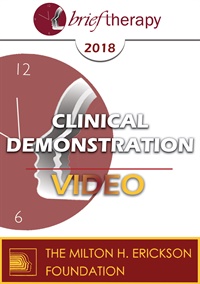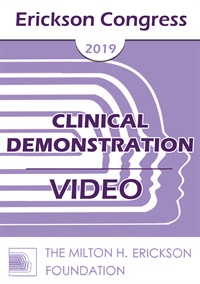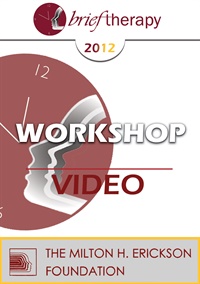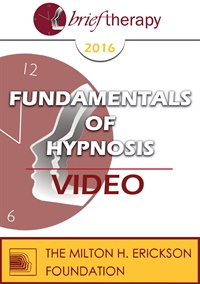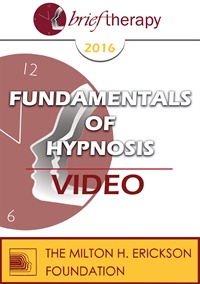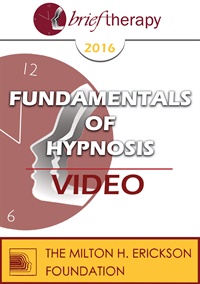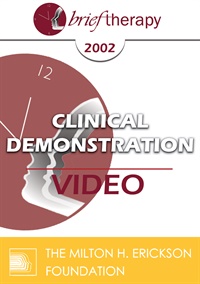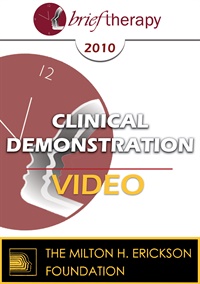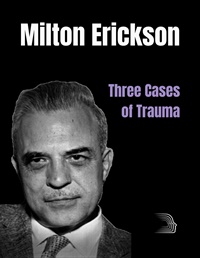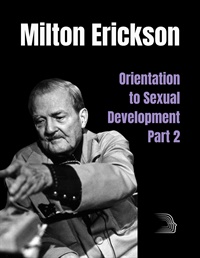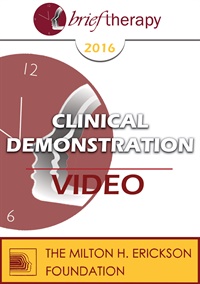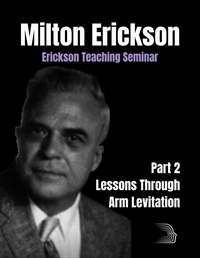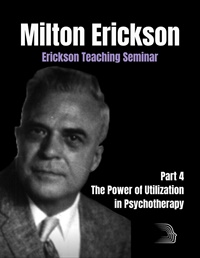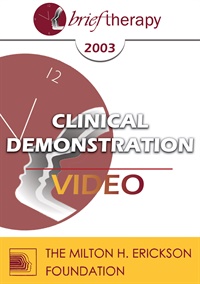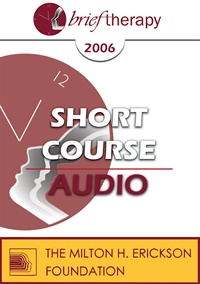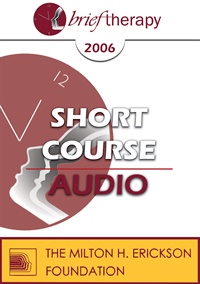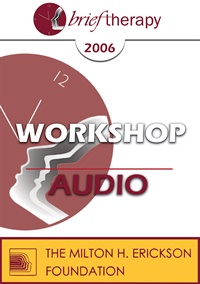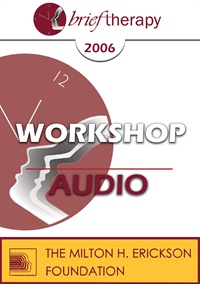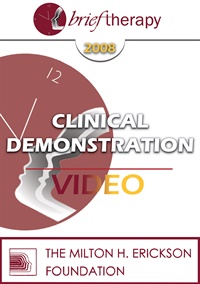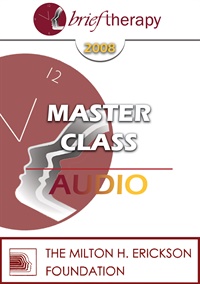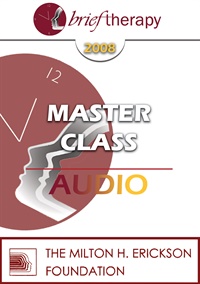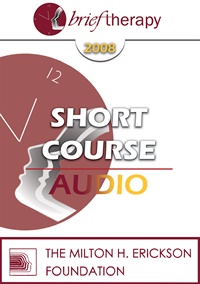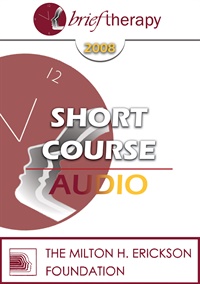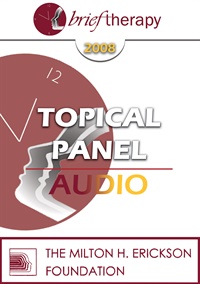Hypnosis
What is Clinical or Therapeutic Hypnosis? Hypnosis is an approach used by licensed and trained clinicians for treating psychological or physical problems. This process typically is started through the use of a hypnotic induction, which creates an altered state of consciousness commonly referred to as trance. During the patient's trance state, their conscious mind is relaxed, allowing the subconscious mind to be accessed. This can allow the therapist to cultivate inner resources, skills, or abilities that may otherwise be unavailable to the conscious mind for one reason or another.
Featured Hypnosis Videos
Fundamentals of Hypnosis
Not sure where to start? The Fundamentals of Hypnosis series has got you covered. From creating inductions, the importance of language in hypnosis, common phenomena to look for in a hypnotic session, to therapeutic techniques that can be enhanced through hypnotic interventions.
Fundamentals of Hypnosis Series
Hypnotic Induction
Hypnotic induction is the process undertaken by a therapist to establish the state or conditions required for hypnosis to occur. The goal is to put the client into an altered consciousness state commonly referred to as trance. There are a variety of ways to use hypnotic inductions. Milton Erickson was known for the handshake induction.
Hypnotic Induction Recordings
The Language of Hypnosis
Hypnosis has a specific grammar designed to elicit phenomenological realizations. Milton Erickson would often use a variety of techniques, including indirect suggestions, metaphors and anecdotes to guide patients towards their goals.
The Language of Hypnosis Recordings
Metaphors
A metaphor is a figure of speech in which a word or phrase is applied to an object, person, or action that it does not literally denote (e.g., the journey of life) for the purpose of creating a forceful analogy. The use of metaphor is commonly used in Ericksonian therapy, especially in conjunction with anecdotes and storytelling. Metaphors can provide vivid visualizations and help simplify complex concepts.
Metaphor Recordings
Storytelling
Stories have the ability to engage people emotionally and to move them to change, but telling the right story at the right time to the right person is an art and a skill. Erickson’s use of stories in his conversations gave people of diverse views, using metaphors where they discovered their own ideas. Each anecdote was put in such a way that quite different people thought it was designed precisely for them. One of Erickson’s greatest skills was his ability to influence people indirectly. Erickson would tell the same case example in different ways to different people. While the essentials of the case remained the same, what he emphasized in the complex story would vary with the analogy he was communicating to that particular listener. What Erickson said and did had multiple purposes and he taught in complex analogies.
Storytelling Recordings
All Hypnosis Recordings
Still looking for more? Here's a listing of all our hypnosis recordings.
- Arm Levitation
- Attunement
- Binds
- Consciousness
- Differentiation
- Dissociation
- Fundamentals of Hypnosis
- Group Induction
- Hypnotic Induction
- Hypnotic Phenomena
- Hypnotherapy
- Language of Hypnosis
- Phenomenology
- Post-Hypnotic Suggestion
- Resistance
- Resources
- Self-Hypnosis
- Trance
- Truisms
- Unconscious Processes
- Yes Set
All Hypnosis Recordings
- Average Rating:
- Not yet rated
- Topic Areas:
- Ericksonian Hypnosis and Therapy Techniques | Seeding | Milton Erickson | Destabilization | Dissociation | Hypnosis
- Categories:
- Erickson Materials | Erickson Streaming Video Collection | Milton H. Erickson Collections
- Faculty:
- Milton H. Erickson, MD | Jeffrey Zeig, PhD
- Duration:
- 1 hour
- Format:
- Audio and Video
- Original Program Date:
- May 07, 2020
- Short Description:
- In part one of Seeding a Theme - A Teaching Seminar with Milton Erickson, you will witness Erickson seamlessly planting a seed, connecting the dots, developing a theme, and closing the loop in one class period. You will learn how Erickson conducted dissociation through the tempo, content and tone of his words.
- Price:
- $29.95 - Base Price
Credit available - Click Here for more information
- Average Rating:
- Not yet rated
- Topic Areas:
- Ericksonian Hypnosis and Therapy Techniques | Hypnosis | Milton Erickson | Trance | Utilization | Arm Levitation | Hypnotic Phenomena
- Categories:
- Erickson Materials | Erickson Streaming Video Collection | Milton H. Erickson Collections | Online Continuing Education
- Faculty:
- Milton H. Erickson, MD | Jeffrey Zeig, PhD
- Duration:
- 1 hour
- Format:
- Audio and Video
- Original Program Date:
- May 07, 2020
- Short Description:
- In part two of a Teaching seminar with Milton Erickson, you will witness how Erickson carefully observed and utilized a student’s non-verbal behaviors to developing a trance experience using arm levitation while simultaneously interacting to teach other students. You will see how Dr. Erickson strategically used hypnotic phenomena.
- Price:
- $29.95 - Base Price
- Average Rating:
- Not yet rated
- Topic Areas:
- Milton Erickson | Utilization | Ericksonian Psychotherapy | Psychotherapy | Ericksonian Hypnosis and Therapy Techniques | Hypnosis
- Categories:
- Erickson Materials | Erickson Streaming Video Collection | Milton H. Erickson Collections
- Faculty:
- Jeffrey Zeig, PhD | Milton H. Erickson, MD
- Duration:
- 1 hour
- Format:
- Audio and Video
- Original Program Date:
- Jul 22, 2020
- Short Description:
- Join Milton Erickson at his teaching seminar in the late 1970s. You will encounter his innovative teaching methods prompting students to activate their utilization skills. Learn Erickson's process for creating memorable interventions with clients overly concerned about body image. Encounter his method of using nonverbal methods to evoke adaptive responses. Introduction and annotations by Jeff Zeig, Erickson Foundation Director.
- Price:
- $29.95 - Base Price
Credit available - Click Here for more information
- Average Rating:
- Not yet rated
- Topic Areas:
- Hypnosis | Advanced Techniques of Hypnosis & Therapy | Continuing Education | Ericksonian Hypnosis and Therapy Techniques | Hypnotherapy | Milton Erickson | Communication | Metaphors
- Categories:
- Advanced Techniques of Hypnosis & Therapy | Featured | Training Videos | Online Continuing Education | Milton H. Erickson Collections
- Faculty:
- Jeffrey Zeig, PhD | Milton H. Erickson, MD
- Duration:
- 02:38:00
- Format:
- Audio and Video
- Original Program Date:
- Dec 31, 1977
- Short Description:
- This training tool contains segments of hypnotherapy conducted by Erickson, with the same subject, on two consecutive days in 1978. Erickson demonstrates how symbols may be used as metaphoric forms of communication to foster new ideas and understandings. Zeig discusses Erickson’s technique.
- Price:
- $75.00 - Base Price
Credit available - Click Here for more information
- Average Rating:
- Not yet rated
- Topic Areas:
- Hypnosis | Hypnotic Induction | Advanced Techniques of Hypnosis & Therapy | Continuing Education | Ericksonian Hypnosis and Therapy Techniques | Milton Erickson
- Categories:
- Advanced Techniques of Hypnosis & Therapy | Featured | Training Videos | Online Continuing Education | Milton H. Erickson Collections
- Faculty:
- Milton H. Erickson, MD | Jeffrey Zeig, PhD
- Duration:
- 01:54:00
- Format:
- Audio and Video
- Original Program Date:
- Dec 31, 1963
- Short Description:
- The Process of Hypnotic Induction features Erickson in 1964, working with several different subjects. He demonstrates how to individualize the method of induction to fit the unique characteristics of the individual. Jeffrey Zeig discusses the microdynamics of technique that Erickson used in his 1964 inductions. Comments are aimed at clinicians experienced in hypnosis looking to refine their skills.
- Price:
- $75.00 - Base Price
- Average Rating:
- Not yet rated
- Topic Areas:
- Hypnosis | Advanced Techniques of Hypnosis & Therapy | Ericksonian Hypnosis and Therapy Techniques | Marriage | Milton Erickson | Seeding | Utilization
- Categories:
- Advanced Techniques of Hypnosis & Therapy | Training | Milton H. Erickson Collections | World Languages | German
- Faculty:
- Milton H. Erickson, MD | Jeffrey Zeig, PhD
- Duration:
- 2 Hours 24 Min
- Format:
- Audio and Video
- Original Program Date:
- Dec 31, 1977
- Short Description:
- This hypnotherapeutic session took place in 1978, and decades later, it’s just as powerful and engaging. Enhancing the viewer’s learning experience is Dr. Zeig’s discussion of the underlying elements of Erickson’s methods: the ARE model of instruction; the art of parallel communication; targeted utilization; and the use of implication. Erickson’s fluid repertoire, drawn from systematic thinking, includes the use of anecdotes, symbolic communication, and strategic seeding. The elicitation of solutions, based on promoting constructive associations and flexible thoughts and feelings, is an area of particular interest and one in which Erickson was especially elegant.
- Price:
- $65.00 - Base Price
- Average Rating:
- Not yet rated
- Topic Areas:
- Advanced Techniques of Hypnosis & Therapy | Ericksonian Hypnosis and Therapy Techniques | Hypnosis | Milton Erickson | Psychotherapy | Resistance
- Bundle(s):
- Spanish Erickson Video Bundle
- Categories:
- Spanish | Advanced Techniques of Hypnosis & Therapy | Milton H. Erickson Collections | World Languages
- Faculty:
- Milton H. Erickson, MD | Jeffrey Zeig, PhD
- Duration:
- 1 Hour 55 Minutes
- Format:
- Audio and Video
- Original Program Date:
- Dec 31, 1978
- Short Description:
- El Dr. Zeig introduce original de 1979 metraje y revela patrones del Dr. Erickson con entendimientos limpiados de discusión con el propio Dr. Erickson
- Price:
- $75.00 - Base Price
Credit available - Click Here for more information
- Average Rating:
- Not yet rated
- Topic Areas:
- Hypnosis | Psychotherapy | Advanced Techniques of Hypnosis & Therapy | Continuing Education | Resistance | Ericksonian Hypnosis and Therapy Techniques | Milton Erickson | Confusion Technique | Naturalistic | Seeding | Hypnotherapy
- Categories:
- Advanced Techniques of Hypnosis & Therapy | Featured | Training Videos | Online Continuing Education | Milton H. Erickson Collections
- Faculty:
- Milton H. Erickson, MD | Jeffrey Zeig, PhD
- Duration:
- 1 Hour 55 Min
- Format:
- Audio and Video
- Original Program Date:
- Dec 31, 1978
- Short Description:
- In 1979, Milton Erickson and Jeffrey Zeig spent five hours reviewing a demonstration that Erickson conducted at a teaching seminar. That demonstration is now available as a training video for Ericksonian practitioners. Erickson’s experiential methods include the symbolic use of hypnotic phenomena, encouraging resistance, naturalistic confusion technique, seeding, and using isomorphic anecdotes. Jeffrey Zeig discusses the mechanics of Erickson’s unique approach to psychotherapy. Working with Resistance provides an opportunity to watch a master hypnotherapist demonstrate his technique.
- Price:
- $75.00 - Base Price
- Average Rating:
- Not yet rated
- Topic Areas:
- Clinical Demonstrations | Hypnosis | Art and Creativity | Brief Therapy | Four-Stage Creative Process | Genomics | Group Induction | Hypnotic Induction
- Categories:
- Brief Therapy Conference | Brief Therapy Conference 2002
- Faculty:
- Ernest Rossi, PhD
- Duration:
- 55:29
- Format:
- Audio and Video
- Original Program Date:
- Dec 13, 2002
- Short Description:
- Educational Objectives: 1) To describe the group induction of therapeutic hypnosis with ideodynamic methods. 2) To list the four stages of the creative process in therapeutic hypnosis.
- Price:
- $29.00 - Sale Base Price - $59.00
- Average Rating:
- Not yet rated
- Topic Areas:
- Clinical Demonstrations | Pain and Healing | Brief Therapy | Hypnosis | Trance
- Categories:
- Brief Therapy Conference | Brief Therapy Conference 2003
- Faculty:
- Stephen Lankton, MSW
- Duration:
- 59:27
- Format:
- Audio and Video
- Original Program Date:
- Dec 12, 2003
- Short Description:
- Educational Objectives: 1) To describe the use of three trance phenomena in the reduction of pain. 2) To describe how hypnosis for pain control can be introduced in brief therapy.
- Price:
- $29.00 - Sale Base Price - $59.00
- Average Rating:
- Not yet rated
- Topic Areas:
- Clinical Demonstrations | Hypnosis | Psychotherapy | Brief Therapy
- Categories:
- Brief Therapy Conference | Brief Therapy Conference 2006
- Faculty:
- Stephen Lankton, MSW
- Duration:
- 54:30
- Format:
- Audio and Video
- Original Program Date:
- Dec 08, 2006
- Short Description:
- BT06 Clinical Demonstration 10 - Introducing Hypnosis into Psychotherapy - Stephen Lankton, MSW, DAHB
- Price:
- $29.00 - Sale Base Price - $59.00
- Average Rating:
- Not yet rated
- Topic Areas:
- Short Courses | Brief Therapy | Hypnosis | Therapist Development
- Categories:
- Brief Therapy Conference | Brief Therapy Conference 2006
- Faculty:
- Rubin Battino, MS
- Duration:
- 1:19:30
- Format:
- Audio Only
- Original Program Date:
- Dec 07, 2006
- Short Description:
- The expectation of the therapist that therapy can be both very brief and effective is the essence of working in the very brief mode, i.e., the therapist rarely sees the client more than one or two times. Typical methods used are: the miracle question, changing personal history, guided metaphor, conversational reframing, Rossi's "moving hands," and hypnosis. Case examples will be given, and the group will be invited to participate in a brief hypnotic change experience.
- Price:
- $15.00 - Base Price
- Average Rating:
- Not yet rated
- Topic Areas:
- Short Courses | Brief Therapy | Dreamwork | Hypnosis | Metaphors | Trauma
- Categories:
- Brief Therapy Conference | Brief Therapy Conference 2006
- Faculty:
- Deborah Beckman
- Duration:
- 1:18:59
- Format:
- Audio Only
- Original Program Date:
- Dec 07, 2006
- Short Description:
- Dreaming is a vital, nightly function of the brain. Disturbing dreams or recurrent nightmares are frequent symptoms of an acute focus on unresolved conflicts and events. Clients can learn to reclaim comforting sleep even before the overt reasons for seeking therapy are directly addressed. The potential of individualized metaphors structured within lucid dreaming empowers clients to "seize" the night." Hypnotic techniques offer an intriguing path that bypasses a client's ingrained fear of "falling to sleep."
- Price:
- $15.00 - Base Price
- Average Rating:
- Not yet rated
- Topic Areas:
- Workshops | Brief Therapy | Hypnosis | Psychotherapy
- Categories:
- Brief Therapy Conference | Brief Therapy Conference 2006
- Faculty:
- Stephen Lankton, MSW
- Duration:
- 2:37:19
- Format:
- Audio Only
- Original Program Date:
- Dec 10, 2006
- Short Description:
- Research shows that treatment paired with hypnosis is more effective than treatment alone for many types of problems. The science and art of hypnosis is now widely recognized as a component tool for psychotherapy and has been employed successfully as a comfortable part of private practice and agency practice for years. As hypnosis spreads into the mainstream of psychotherapy, it is important to get competent information regarding its use. Lacking that, many practitioners do not make use of the advantages it provides as an adjunct to a well-rounded set of clinical skills. This workshop is intended to correct that lack of understanding and training in this important area. The rationale, indications and basic use will be explained and demonstrated with practical exercises to help convey the key language skills that are requisite.
- Price:
- $15.00 - Base Price
- Average Rating:
- Not yet rated
- Topic Areas:
- Workshops | Hypnosis | Experiential Therapy | Brief Therapy | Homework
- Categories:
- Brief Therapy Conference | Brief Therapy Conference 2006
- Faculty:
- Jeffrey Zeig, PhD
- Duration:
- 1:58:24
- Format:
- Audio Only
- Original Program Date:
- Dec 10, 2006
- Short Description:
- An experiential orientation empowers therapeutic change. Dramatic experiential methods can be used by any clinician in every stage of the therapeutic process including assessment, in session treatment and homework assignments. Techniques to be demonstrated and practiced include therapist sculpting, symbolic assignments and analogical tasks.
- Price:
- $15.00 - Base Price
BT08 Clinical Demonstration 07 - Using Hypnosis in a Brief Therapy Demo - Stephen Lankton, MSW, DAHB
- Average Rating:
- Not yet rated
- Topic Areas:
- Clinical Demonstrations | Brief Therapy | Hypnosis
- Categories:
- Brief Therapy Conference | Brief Therapy Conference 2008
- Faculty:
- Stephen Lankton, MSW
- Duration:
- 58:19
- Format:
- Audio and Video
- Original Program Date:
- Dec 13, 2008
- Short Description:
- BT08 Clinical Demonstration 07 - Using Hypnosis in a Brief Therapy Demo - Stephen Lankton, MSW, DAHB
- Price:
- $29.00 - Sale Base Price - $59.00
- Average Rating:
- Not yet rated
- Topic Areas:
- Fundamentals of Hypnosis | Hypnosis | Phenomenology | Hypnotic Induction | Trance | Tailoring
- Categories:
- Brief Therapy Conference | Brief Therapy Conference 2008
- Faculty:
- Jeffrey Zeig, PhD
- Duration:
- 2:23:04
- Format:
- Audio and Video
- Original Program Date:
- Dec 11, 2008
- Short Description:
- Hypnosis is not a thing, but a way that things happen. To make hypnosis happen a clinician needs to understand the underlying architecture of trance. Eliciting systemic components elicits trance. The grammar, context and relational elements of eliciting these components will be explained. We will develop an induction model based on three steps. This workshop will consist of lecture, demonstration and small group practice.
- Price:
- $29.00 - Base Price
- Average Rating:
- Not yet rated
- Topic Areas:
- Fundamentals of Hypnosis | Hypnosis | Language of Hypnosis | Indirection
- Categories:
- Brief Therapy Conference | Brief Therapy Conference 2008
- Faculty:
- Stephen Lankton, MSW
- Duration:
- 2:09:12
- Format:
- Audio and Video
- Original Program Date:
- Dec 12, 2008
- Short Description:
- The rationale for the use of indirection will be presented. In this session you will learn and practice the construction of fundamental forms of indirection language. Participants will practice five forms of indirect suggestions and three forms of binds. A demonstration using these forms will illustrate the implementation of this set of language techniques for the induction and treatment process. The use of indirect suggestions in further treatment will be outlined.
- Price:
- $29.00 - Base Price
- Average Rating:
- Not yet rated
- Topic Areas:
- Fundamentals of Hypnosis | Hypnosis | Hypnotic Induction | Resources | Trance
- Categories:
- Brief Therapy Conference | Brief Therapy Conference 2008
- Faculty:
- Stephen Gilligan, PhD
- Duration:
- 2:26:46
- Format:
- Audio and Video
- Original Program Date:
- Dec 12, 2008
- Short Description:
- This session explores various methods for eliciting hypnotic trance in a therapy situation. The relevance of utilizing key aspects of a client's resources and symptoms, as well as different ways to gage and incorporate ongoing feedback will be emphasized.
- Price:
- $29.00 - Base Price
- Average Rating:
- Not yet rated
- Topic Areas:
- Fundamentals of Hypnosis | Hypnosis | Hypnotic Induction
- Categories:
- Brief Therapy Conference | Brief Therapy Conference 2008
- Faculty:
- Ernest Rossi, PhD
- Duration:
- 2:17:49
- Format:
- Audio and Video
- Original Program Date:
- Dec 14, 2008
- Short Description:
- Three brief, novel, creative and easy to learn approaches to the induction of therapeutic hypnosis that are appropriate for practically any client issue with any theoretical orientation will be shared with participants. All of these approaches have evolved from Erickson's original "hand levitation technique" and are consistent with the principles of art, beauty, and truth presented in the new 2008 series of "The Collected Works of Milton H. Erickson," Vol.1, "The Nature of Therapeutic Hypnosis."
- Price:
- $29.00 - Base Price
- Average Rating:
- Not yet rated
- Topic Areas:
- Master Classes | Brief Therapy | Experiential Therapy | Gestalt | Hypnosis | Ericksonian Hypnosis and Therapy Techniques
- Categories:
- Brief Therapy Conference | Brief Therapy Conference 2008
- Faculty:
- Jeffrey Zeig, PhD | Erving Polster, PhD
- Duration:
- 3:13:17
- Format:
- Audio Only
- Original Program Date:
- Dec 15, 2008
- Short Description:
- Gestalt therapy and Ericksonian hypnotherapy are experiential methods of change. In combination they can be synergistic. Psychotherapy is best when clients have a first hand experience of an alive therapeutic process. Such dynamic, empowering experiences pave the way for dynamic understandings. Drs. Polster and Zeig will offer brief introductions to their approaches. They will demonstrate their methods through live therapeutic sessions and they will engage with each other and the participants to examine commonalities and differences in their work.
- Price:
- $15.00 - Base Price
- Average Rating:
- Not yet rated
- Topic Areas:
- Master Classes | Brief Therapy | Experiential Therapy | Gestalt | Hypnosis | Ericksonian Hypnosis and Therapy Techniques | Hypnotherapy
- Categories:
- Brief Therapy Conference | Brief Therapy Conference 2008
- Faculty:
- Jeffrey Zeig, PhD | Erving Polster, PhD
- Duration:
- 2:31:17
- Format:
- Audio Only
- Original Program Date:
- Dec 15, 2008
- Short Description:
- Gestalt therapy and Ericksonian hypnotherapy are experiential methods of change. In combination they can be synergistic. Psychotherapy is best when clients have a first hand experience of an alive therapeutic process. Such dynamic, empowering experiences pave the way for dynamic understandings. Drs. Polster and Zeig will offer brief introductions to their approaches. They will demonstrate their methods through live therapeutic sessions and they will engage with each other and the participants to examine commonalities and differences in their work.
- Price:
- $15.00 - Base Price
- Average Rating:
- Not yet rated
- Topic Areas:
- Short Courses | Brief Therapy | Communication | Ericksonian Hypnosis and Therapy Techniques | Hypnosis | Language of Hypnosis
- Categories:
- Brief Therapy Conference | Brief Therapy Conference 2008
- Faculty:
- Kate Cohen-Posey, MS
- Duration:
- 1:30:12
- Format:
- Audio Only
- Original Program Date:
- Dec 11, 2008
- Short Description:
- A person may say, "Don't ever . . . lie to me again!" or "You can . . . always tell me the truth." In either case, hypnotic language has been used to evoke undesirable or desirable behavior. This workshop will take Ericksonian linguistic patterns and export them into everyday environments. Exercises, role-plays, and brain storming will show how to make lasting changes in speech habits when addressing resistant family members and co-workers.
- Price:
- $15.00 - Base Price
- Average Rating:
- Not yet rated
- Topic Areas:
- Short Courses | Addiction | Hypnosis | Trance | Trauma | Brief Therapy | Dissociation
- Categories:
- Brief Therapy Conference | Brief Therapy Conference 2008
- Faculty:
- Albina Tamalonis, PsyD
- Duration:
- 1:31:45
- Format:
- Audio Only
- Original Program Date:
- Dec 11, 2008
- Short Description:
- People who are traumatized, and/or have one of the multitudes of addictive disorders are, in great part, dissociated from their physical reality. There is research which indicates that people who exercise are more likely to suffer from less anxiety, pain and depression. This short course offers a practical approach to overcoming people's reluctance to exercise by using active-alert hypnosis and music. By listening to hypnosis with music while exercising, people can alter their perceptions of pain, time, effort and pleasure. The words of the hypnosis are taken from the works of Milton H. Erickson, Jeffrey Zeig, Michael Yapko and Eva Banyai. Their different contributions will be delineated and explained.
- Price:
- $15.00 - Base Price
- Average Rating:
- Not yet rated
- Topic Areas:
- Topical Panels | Sex and Sexuality
- Categories:
- Brief Therapy Conference | Brief Therapy Conference 2008 | Pioneers in Couples and Family Therapy
- Faculty:
- Florence Kaslow, PhD, ABPP | Michele Weiner-Davis, LCSW | Jeffrey Zeig, PhD
- Duration:
- 1:00:26
- Format:
- Audio Only
- Original Program Date:
- Dec 13, 2008
- Short Description:
- This panel on brief sex therapy explores a range of clinical concerns including low-desire marriages, sexual avoidance, and early developmental influences on sexuality. Speakers underscore the value of culturally attuned care, life-span intimacy, and therapeutic flexibility—from hypnosis to direct communication. Emphasis is placed on helping couples navigate difference with clarity, compassion, and a deeper understanding of the emotional roots of sexual disconnection.
- Price:
- $15.00 - Base Price



